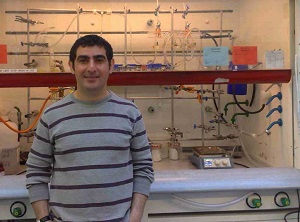
Towards Low-Cost and Sustainable Dye-Sensitized Solar Cells: Synthesis of Photostable and Photoactive Perylene Imides for DSSC Applications (February 12th, 2014 –December 31st, 2016)
World energy demand and consumption is increasing and there is a need to find a way of making a suitable transition to clean and cheap renewable fuels. Solar radiation is the most abundant energy source of our planet, and there is an increasing interest in developing devices that convert sunlight into electrical energy. Making solar energy economical is one of the top priority engineering problems (grand challenges) of the 21st century.
Solar photovoltaic (PV) technology harnesses direct solar energy. Electricity is generated via direct conversion of sunlight to electricity by PV cells. There are several types of photovoltaic technology, differentiated by the type of material used in the cell's absorber. Among these, Dye Sensitized Solar Cells (DSSCs) are cheap and promising alternatives. Although photovoltaic effect was known over a hundered year, this was actually first utilized by photosynthesizing bacteria, the precursors of green plants, over 3 billion years ago, and we have a lot to learn from nature. The first two steps of photosynthesis involve capturing photons from the Sun and using that energy to create a flow of electrons. DSSC is a solar cell technology that tries to mimic the first two steps of photosynthesis.
Major advantages of DSSCs over the other available photovoltaic technologies are:
i. They are much less expensive to produce,
ii. Toxicity of the materials used considered to be lower,
iii. They can operate in low-light conditions, such as cloudy days and in indirect sunlight. Also they can operate over a wide range of temperature,
iv. They can be constructed using a wide-variety of materials, including flexible materials, and be used on transparent materials like windows.
DSSCs prepared thus far only achieved around 12 percent power conversion efficiency. Major advances in the next generation clean energy technologies would be possible with the development of new materials. Therefor, our approach to the problem involves the investigation of structure-property relationship of certain class of dye molecules that are promising candidates as sensitizer components in DSSC applications.
The primary goal of this project was to design, synthesize and evaluate new organic dyes as sensitizers in dye sensitized solar cell applications. The main focus was on synthesis, characterization, and study of the photophysical, optical and structural properties of the sensitizers.We have prepared a number of novel dye molecules and investigated their structure-property relations that are relevant to possible solar cell applications. Our results demonstrated that these molecules show desirable properties like, solar light harvesting over a wide range of wavelengths, efficient photon harvesting ability, high processability and high thermal stabilities. Certain facilities of Chemistry Department at main campus-Ankara were used. Luckily we have access to the Main Campus' high end state-of-art research equipment.
Currently a master student and a 4th year undergraduate student is working on the synthesis of structurally related dye molecules, which will enable us to compare the properties of structurally modified but related compounds to that of prepared within the scope of completed project. In addition to this, we are planning to investigate the electrochemical properties of the prepared dyes that will provide insight into their oxidation-reduction, and band-gap properties.
Research Organizations, research groups and scientists working in the field of chemistry and materials science, technology developers in the field of photovoltaics, university students at all levels, are the primary target audience. As well, research in this field provides intelligence for organisations developing policy and strategy.
We will be shortly publishing a number of scientific articles, and present our work in an international conference. Sharing our research goals and project outcomes may help collaboration with business, government, scientific organisations, and the public for creating awareness.
Project helped us to establish a functional synthetic chemistry research laboratory at METU-NCC. Our students have the chance engaging with our research activities. In a broader sense, I am confident to say that efforts of global science community in this line, that we are surely part of, eventually will lead to clean, and cheap energy that all people will have access to.
Research Group
Project coordinator, Asst. Prof. Dr. Mustafa Erkut Özser was educated in Ankara-Turkey, Southampton-UK, Mülheim-germany and Famagusta-Northern Cyprus. My doctoral research in synthetic and mechanistic photochemistry was performed at the Max-Planck Institute in Mülheim, Germany. He was granted postdoctoral research fellowships in Miami-USA and Edinburgh-UK for designing and synthesis of functional small molecules. These molecules can perform either kinetic or photoswitchable propertiesJoined Metu-NCC in 2013, and his current research is on the synthesis of dye moleules for Dye sensitized solar cell (DSSC) applications.

Other than project coordinator, Dr. Süleyman Aşır was also involved in the project as researcher. As Dr. Aşır left the project, a Masters' student, Samuel Asumadu-Sarkodie, was joined the group. During this time, another masters student Obaidullah Mohiuddin, and a 3rd year undergraduate Chemical Engineering student, Gözde Özeşme, has joined to the research group to work in the project. Under coordinator's guidance, students carried out the major laboratory work like synthesis and purification of the dye-molecules, and helped in characterizations.
- Click here to read past news of ongoing cutting-edge research at our campus.






